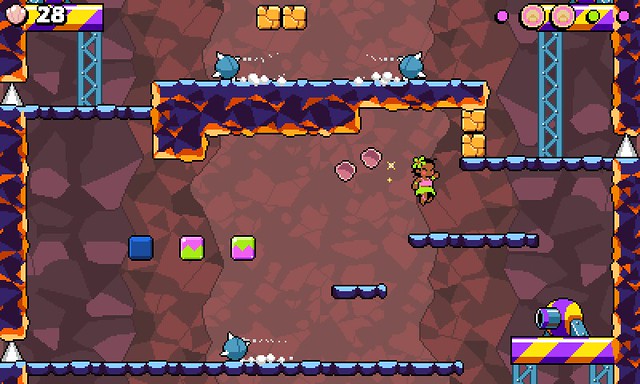Posts from ‘Previews’ Category
DevLog Spotlight: Leilani’s Island
By: Derek Yu
On: July 28th, 2016
I started work on it around a year ago on a whim because I was reading a lot of game design articles and couldn’t resist the idea of a small platform game. It’s really expanded a lot beyond that though! I’d like to start showing it to and discussing it with more people as I continue. The aim of the devlog is to show new exciting things that go in, but also discuss some of my design processes and that kind of thing.
Leilani’s Island lavishes attention to its details – watching Leilani roll into an enemy close-up reveals all kinds of design considerations at play, from particle effects to physics. You can just tell that it feels really good to control. This attention to detail is a quality that’s also reflected in the devlog – creator Ishi has been updated the log at least once a week since February, 2015, revealing the game’s influences and evolving design. According to Ishi, Leilani’s Island draws some inspiration from the personality and physics of Wario Land and Donkey Kong Country, but in the animated gifs he’s posted Leilani promises to be even more intricate than the games from either of those series. The artwork, animation, and music (by Leila “Woofle” Wilson) should be at least as good as Nintendo and Rare’s work on those titles.
Preview: Highfleet
By: Derek Yu
On: July 18th, 2016
The other day, I was wondering to myself: “What ever happened to the guy who made Hammerfight? I liked that game.” Hammerfight, released in 2009 by Russian game-maker Konstantin Koshutin, is an action game about piloting flying vehicles armed with medieval weapons like hammers, maces, flails, and swords as well as the occasional long-range cannon. Its dusty Steampunk world was beautifully rendered – bashing it out with mutant bugs and other pilots was often as lovely as it was brutal, with colorful faction banners streaming about and little people cheering you on in the background. I quite enjoyed knocking my enemies about, too, since a meaty hit could send someone’s airship smashing into a wall, with bricks flying everywhere. Unfortunately, the physics-based movement also took its toll on my poor wrists and constantly swinging my mouse around in circles became painful and repetitive after awhile.
Koshutin’s newest project, Highfleet, seems to share some things in common with Hammerfight: mid-air duels in a dusty, lovingly-rendered world. Instead of floating ships with melee weapons, however, it looks as though you’ll be piloting more traditional aircraft and engaging in dogfights not dissimilar to Vlambeer’s Luftrausers (but slower-paced). From browsing the game’s Facebook page and Twitter, it looks like there will be a lot more to the game, too, like an overworld map and ship construction. Could be really cool (and a lot easier on my wrists).
No release date for the game has been announced.
Kickstart This: Tower 57
By: Derek Yu
On: August 15th, 2015
Tower 57 is a gorgeous twin-stick shooter that’s being Kickstarted right now. The game’s developers are paying a lot of attention to graphical detail – as you (and possibly a friend) blast your way up the titular Tower 57, it seems like you’ll be admiring Cyangmou‘s superb pixel art only as long as it takes to destroy it into lots of itty bitty little pieces. One for the fans of the Bitmap Brothers and their classic shooter, The Chaos Engine.
More information (and plenty of fun animated gifs) are available on the Tower 57 devlog.
Doujin A-Go-Go: Comiket 88 and BitSummit 2015
By: Derek Yu
On: August 13th, 2015
This year’s Comiket, Japan’s premiere festival for self-published works, is starting tomorrow (August 14-16). As in previous years, the doujin shmup developer Edelweiss has put together a long compilation video that combines trailers for a number of games that will be available at the festival. Links to each of the games featured in the video are available here on Edelweiss’s website.
Coinciding with Comiket is a doujin games sale on Steam, including big discounts on La Mulana and a number of highly-regarded shoot ’em ups like Crimzon Clover and Kamui. Or if participating in an underwater deathmatch as a laser-shooting barnacle is more your thing, check out NEO AQUARIUM – The King of Crustaceans.
Also, earlier this summer was the third BitSummit, a Japanese indie games conference that takes place in Kyoto. Unlike Comiket, which features all kinds of amateur media and fan works, BitSummit is focused entirely on promoting the indie game community in Japan and helping their game developers share knowledge, network, and get noticed, much in the way that the Independent Games Summit and Festival do for devs that attend GDC. So far it seems to be a great success, with plenty of press coverage and new partnerships, including one with the Indie MEGABOOTH. This Verge article has a nice round-up of some of the games on the show floor.
It’s great to see the Japanese indie and doujin game communities blossoming and expanding their reach internationally. These days it’s actually quite easy to find and purchase Japanese indie titles through Steam and Playism, which was unthinkable only a few years ago during the peak of Cave Story fever. I can only imagine that this trend will keep blowing up in the years to come.
DevLog Spotlight: Relativity
By: Derek Yu
On: July 8th, 2015
What if gravity worked differently, and you could walk on walls and ceilings? In the world of Willy Chyr’s RELATIVITY, the universe repeats endlessly in every direction. Falling down actually leads you to the top. In this world, up is down and down is up. It’s all relative.
Willy Chyr has been conscientiously updating his TIGForums devlog for Relativity since November, 2013, when the game was a much-different-looking prototype. An installation artist who studied physics in school, Willy takes us with him step-by-step through the process of developing his game, discussing everything from architecture to Unity technology to game conventions in depth, with plenty of screenshots and gifs to boot. It’s hard to ask anything more of a devlog and the game, which promises beautiful puzzle worlds that repeat infinitely in every direction, is worth checking out.
The game is slated for 2016 release on PlayStation 4, PC, Mac, and Linux.
Kickstart This: Power Drive 2000
By: Derek Yu
On: May 29th, 2015
The release of the cheesy-fun 80’s action parody Kung Fury is coinciding perfectly with the end of the Kickstarter for Power Drive 2000, an 80’s-inspired drift racer complete with a talking car. The six modes planned all seem to be interesting variations on a time trial (i.e. racing alone or against a ghost), but Megacom Games is also planning offline and online multiplayer, so we’ll see how that works out. With 5 days left to go, Power Drive 2000 is about $15,000 USD shy of reaching its mark, so if you’re a fan of racers, you may want to give it a boost (pun sadly intended).
And also check out Drift Stage, which takes a different stylistic approach to the same genre.
One more Power Drive 2000 video after the jump:
Prototype: Butcher
By: Derek Yu
On: May 13th, 2015
Seems like Transhuman Design has been busy, with multiple games being developed by multiple teams in the group. Best known for their team-versus-team games like Soldat and King Arthur’s Gold, one of their upcoming projects that caught my eye is a gory 2d run n’ gun called Butcher that looks and feels like a gratuitous hybrid of Abuse (the old DOS game by Crack Dot Com), Doom, and Liero. The prototype – a short, three-level demonstration – is available to download for Windows and Linux and is also playable in your browser (Chrome recommended).
Trailer: Samorost 3
By: Derek Yu
On: April 24th, 2015
A third Samorost game is “coming later this year”, according to Amanita Design, who released a lovely trailer for the game this month. You’ll definitely want to watch this one fullscreen to see all the little details in the artwork.
Kickstart This: That Dragon, Cancer
By: Derek Yu
On: December 5th, 2014
As a new-ish father, I can’t even imagine going through what Ryan and Amy Green and their family went through (and are still going through). That Dragon, Cancer is a point-and-click game about their 5-year-old son Joel’s four year battle with cancer. Joel died in March. Not a conventional adventure game by any means, the goal of TDC is to go follow the Greens through their experiences in a series of vignettes that appears to mix real world settings (like the hospital) with surreal places and imagery that are meant to evoke certain emotions. Although it’s a nightmare scenario for any parent, the Greens say that their game is ultimately about hope and imagination.
Originally designed as an Ouya exclusive, the game is now slated for a simultaneous release in 2014 on Ouya, Windows, and Mac.
First Playable: Return of the Obra Dinn
By: Derek Yu
On: November 12th, 2014
Lucas Pope has released a very early development build of his latest project, Return of the Obra Dinn. While the website warns that there’s “not much content”, the build does a great job of conveying the game’s wonderful atmosphere and introducing a few of the key concepts behind the title. Obra Dinn is the name of the merchant ship on which your adventure takes place. Lost on route to the Orient in 1802, the ship has returned to port four years later, and you’ve been sent to investigate as an insurance adjustor for the East India Company’s London Office. Figuring out what happened aboard the Obra Dinn appears to be the central premise for the game, but how you accomplish that task is anything but ordinary.
Pope was the creator of the surprise hit Papers, Please, which made the seemingly mundane job of immigration inspector feel exciting and personal. It’s great to see him take that unique outlook into his next game, but with such wildly different themes, mechanics, and audiovisuals (which he describes in great detail in his fantastic TIGForums DevLog). Can’t wait for more.




